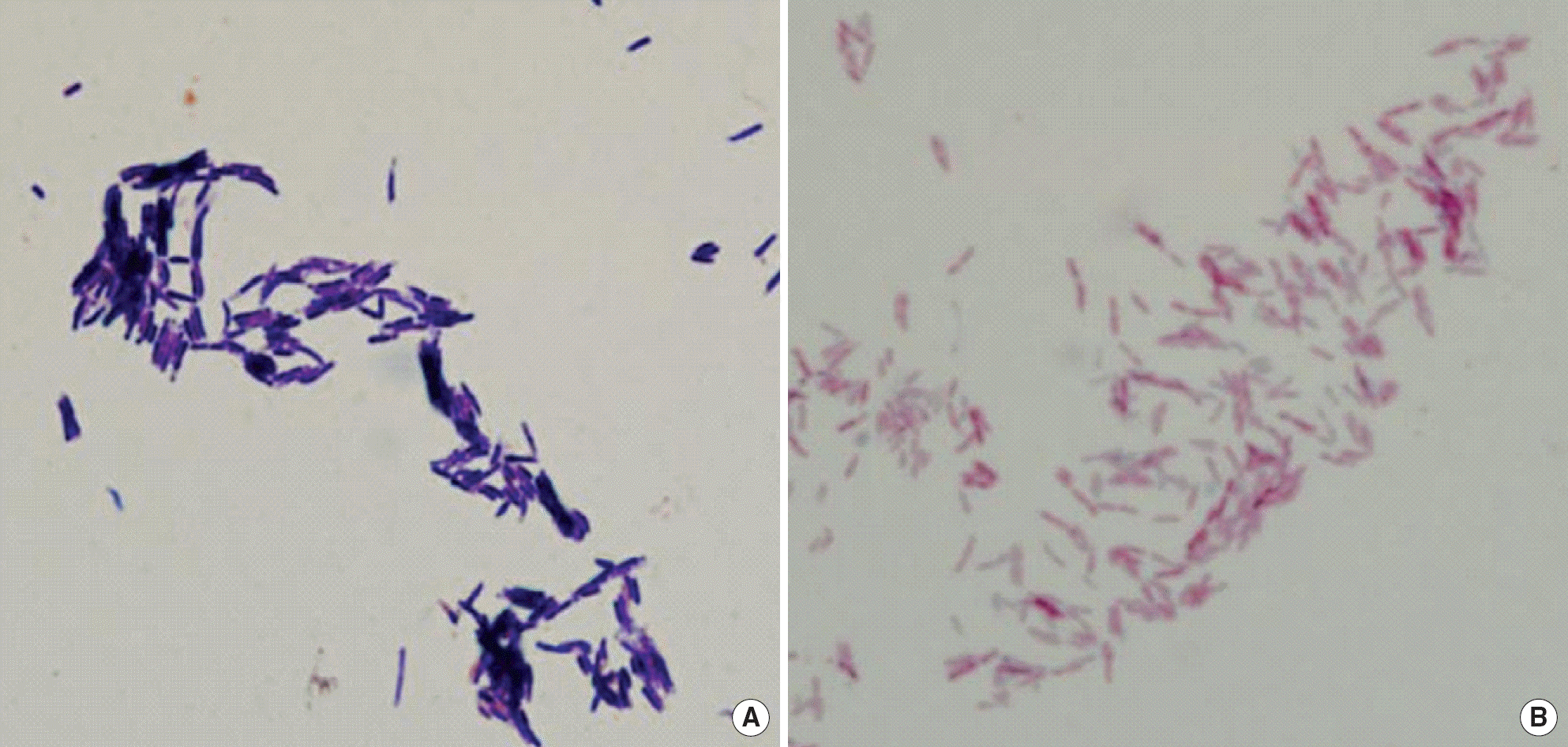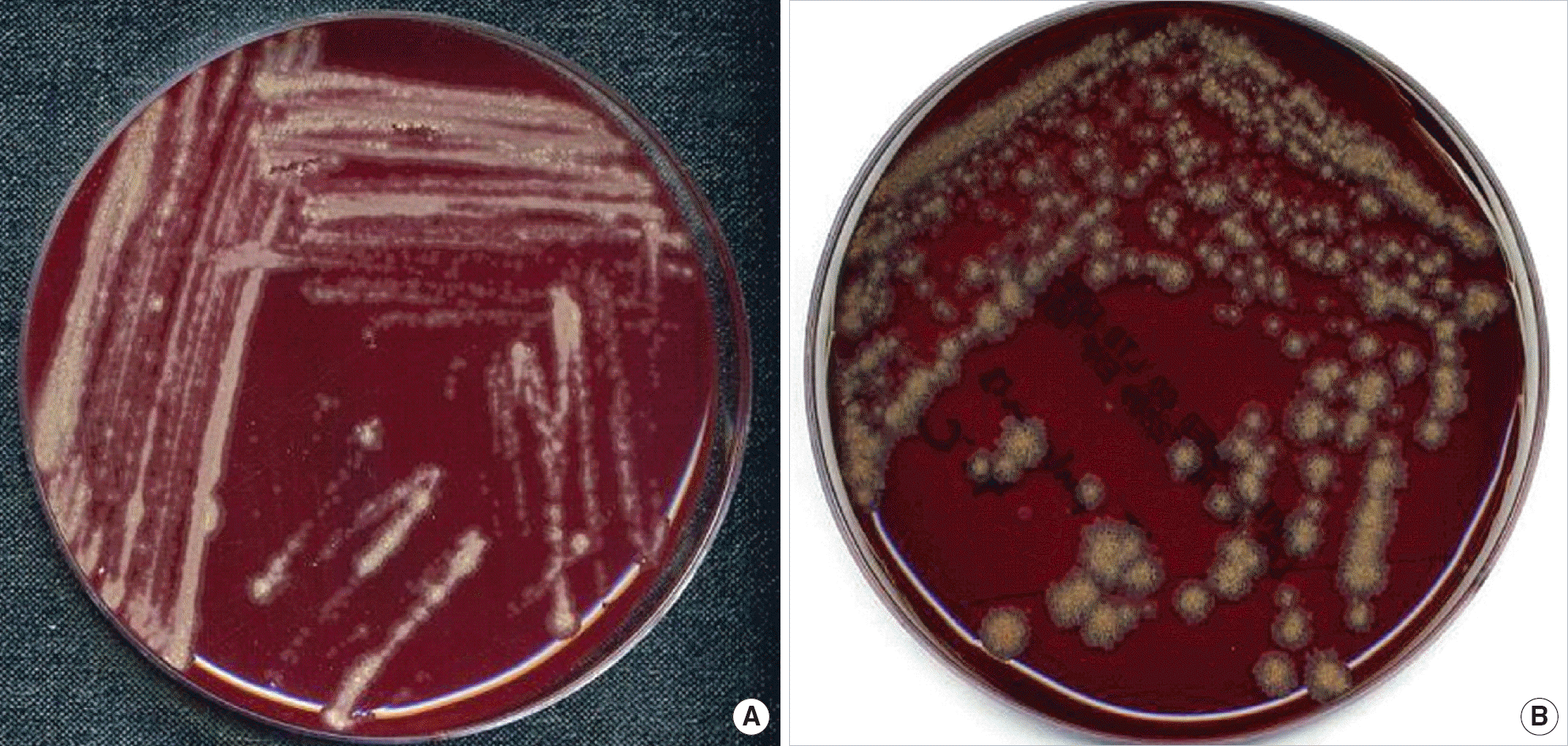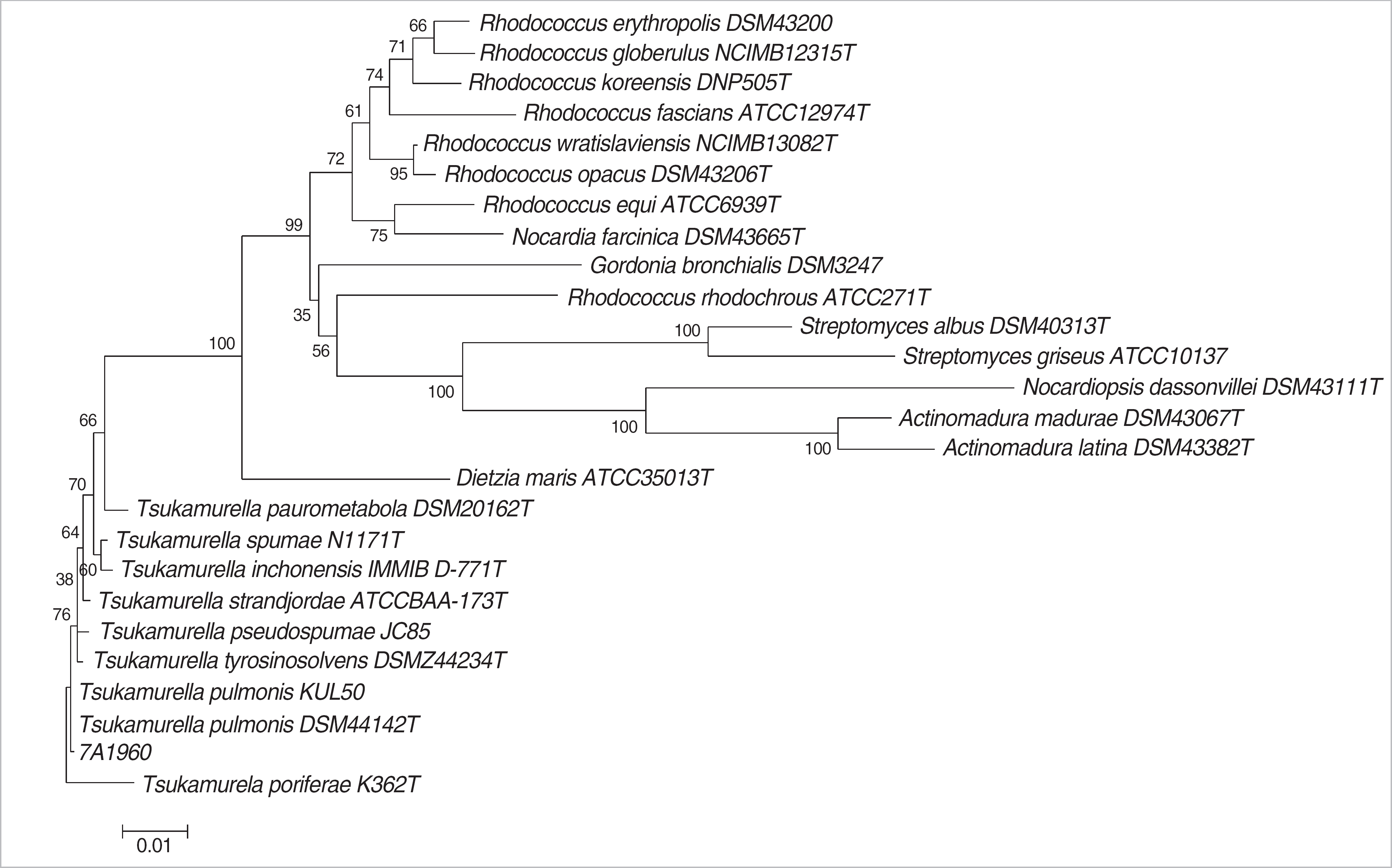Abstract
Tsukamurella pulmonis is an aerobic actinomycete. We report a catheter-related bacteremia of T. pulmonis. A 39 yr-old male with ALL was hospitalized to receive bone marrow transplantation (BMT). Although the patient developed a high fever at the 7th hospital day (HD), it subsided with vancomycin treatment, and he received BMT at 9th HD. Fever resurged at 16th HD despite sustained treatment with vancomycin, meropenem, and amphotericin B, but subsided with removal of Hickman catheter (HC) at 19th HD. Three sets of blood cultures comprising one from the HC and two from venipunctures were taken at 7th, 16th, and 19th HD, and the distal tip of the HC was also cultured. The aerobic vials of all 3 HC-withdrawn blood cultures and one peripheral blood culture taken at 19HD and the HC tip culture grew long, straight, thin gram-positive rods that were positive on modified Kinyoun stain. This organism showed tiny, rough, grey colonies after 3-day incubation and grew to large flat colonies when incubation was extended. It was catalase-positive, urease-positive, and alkaline-slant/alkaline-deep on triple sugar iron agar, and hydrolyzed hypoxanthine. The sequence of 1,296 base pairs of 16S rRNA of this organism showed a 100.0% homology with the published sequence of T. pulmonis DSM 44142T. To our knowledge, this is the first report of T. pulmonis bacteremia in Korea.
REFERENCES
1.Conville PS., Witebsky FG. Nocardia, Rhodococcus, Gordonia, Actinomadura, Streptomyces, and Other Aerobic Actionmycetes. In:. Murray PR, Baron EJ, editors. Manual of clinical microbiology. 9th ed.Washington DC: ASM Press;2007. p. 519–26.
2.Tsukamura M., Kawakami K. Lung infection caused by Gordona aurantiaca (Rhodococcus aurantiacus). J Clin Microbiol. 1982. 16:604–7.
3.Tsukamura M., Hikosaka K., Nishimura K., Hara S. Severe progressive subcutaneous abscesses and necrotizing tenosynovitis caused by Rhodococcus aurantiacus. J Clin Microbiol. 1988. 26:201–5.
4.Prinz G., Ban E., Fekete S., Szabo Z. Meningitis caused by Gordona aurantiaca (Rhodococcus aurantiacus). J Clin Microbiol. 1985. 22:472–4.
5.Lai KK. A cancer patient with central venous catheter-related sepsis caused by Tsukamurella paurometabolum (Gordona aurantiaca). Clin Infect Dis. 1993. 17:285–7.
6.Shapiro CL., Haft RF., Gantz NM., Doern GV., Christenson JC., O'Brien R, et al. Tsukamurella paurometabolum: a novel pathogen causing catheter-related bacteremia in patients with cancer. Clin Infect Dis. 1992. 14:200–3.
7.Chong Y., Lee K., Chon CY., Kim MJ., Kwon OH., Lee HJ. Tsukamurella inchonensis bacteremia in a patient who ingested Hydrochloric acid. Clin Infect Dis. 1997. 24:1267–8.
8.Relman DA. Universal bacterial 16S rRNA amplification and sequencing. Persing DH, Smith TF, editors. Diagnostic molecular microbiology principles and applications. 1st ed.Washington DC: ASM Press;1993. p. 489–95.
9.National Committee for Clinical Laboratory Standards. Interpretive criteria for identification of bacteria and fungi by DNA target sequencing; approved guideline. NCCLS document MM18-A. Wayne, PA: Clinical and Laboratory Standards Institute;2008.
10.National Committee for Clinical Laboratory Standards. Susceptibility testing of Mycobacteria, Nocardiae, and other aerobic Actinomycetes; approved standard. NCCLS document M24-A. Wayne, PA: Clinical and Laboratory Standards Institute;2003.
11.National Committee for Clinical Laboratory Standards. Principles and procedures for blood cultures; approved guideline. NCCLS document M47-A. Wayne, PA: Clinical and Laboratory Standards Institute;2007.
12.Auerbach SB., McNeil MM., Brown JM., Lasker BA., Jarvis WR. Outbreak of pseudoinfection with Tsukamurella paurometabolum traced to laboratory contamination: efficacy of joint epidemiological and laboratory investigation. Clin Infect Dis. 1992. 14:1015–22.
13.Schwartz MA., Tabet SR., Collier AC., Wallis CK., Carlson LC., Nguyen TT, et al. Central venous catheter-related bacteremia due to Tsukamurella species in the immunocompromised host: a case series and review of the literature. Clin Infect Dis. 2002. 35:e72–7.
14.McNeil MM., Brown JM. The medically important aerobic Actinomycetes: epidemiology and microbiology. Clin Microbiol Rev. 1994. 7:357–417.
15.Kattar MM., Cookson BT., Carlson LD., Stiglich SK., Schwartz MA., Nguyen TT, et al. Tsukamurella strandjordae sp. nov., a proposed new species causing sepsis. J Clin Microbiol. 2001. 39:1467–76.
16.Yassin AF., Rainey FA., Brzezinka H., Burghardt J., Rifai M., Seifert P, et al. Tsukamurella pulmonis sp. nov. Int J Syst Bacteriol. 1996. 46:429–36.
17.Bizet C., Barreau C., Harmant C., Nowakowski M., Pietfroid A. Identification of Rhodococcus, Gordona and Dietzia species using carbon source utilization tests (“Biotype-100” strips). Res Microbiol. 1997. 148:799–809.
Fig. 1.
Microscopy of the colonies showing long, thin, straight Gram-positive rods on Gram stain (A) and acid-fastness on modified Kinyoun stain (B).

Fig. 2.
Tsukamurella pulmonis cultures grown on sheep blood agar at 35°C in ambient air showing dry, velvety, greytan colonies at day 3 (A) and yellowish granules on the top of flat colonies with fringed edges at day 6 (B).

Fig. 3.
Unrooted tree showing the phylogenetic relationships of the isolate of this study, 7A1960, and closely related Gram-positive bacteria. The tree was constructed by neighbour joining method using the Kimura two-parameter model and bootstrap values were calculated from 1,000 trees. The scale bar indicates the estimated number of substitutions per 100 nucleotides.

Table 1.
Physiological and biochemical characteristics of the isolate of this study as compared to the biochemical reactions of published type strains [16]
| Characteristic | The isolate of this study | T. pulmonis DSM 44142T | T.incho nensis DSM 44067T | T.paurometabola DSM 20162T | T.tyrosinosolvens DSM 44234T |
|---|---|---|---|---|---|
| Utilization of | |||||
| D-glucose | +∗ | + | + | + | + |
| Arabinose | –† | – | – | – | – |
| D-mannitol | +‡ | + | + | – | + |
| D-maltose | -‡ | – | – | + | + |
| Gluconate | +‡ | + | + | + | + |
| Citrate | -† | - | + | - | + |
| Gelatin | -‡ | - | - | - | - |
| Sucrose | +∗ | + | + | + | + |
| Inositol | -† | - | + | + | + |
| Sorbitol | +∗ | + | + | - | + |
| Rhamnose | -† | - | - | - | - |
| Presence of | |||||
| Urease | +§ | + | + | + | + |
| Catalase | + | + | + | + | + |
| Nitrate reductase | -‖ | - | - | - | - |
| β-Glucosidase | +¶ | + | + | + | + |
| β-Galactosidase | -‖ | + | + | + | + |
| Growth at | |||||
| 24°C | + | + | + | + | + |
| 31°C | + | + | + | + | + |
| 37°C | + | + | + | + | + |
| 45°C | - | - | + | - | - |
| Hydrolysis of | |||||
| Hypoxanthine | + | -/+ | + | - | + |
| Tyrosine | - | - | - | - | + |
| Xanthine | - | - | - | - | + |
| Casein | - | - | - | - | - |
| Esculin | +‖ | + | + | + | + |




 PDF
PDF ePub
ePub Citation
Citation Print
Print


 XML Download
XML Download